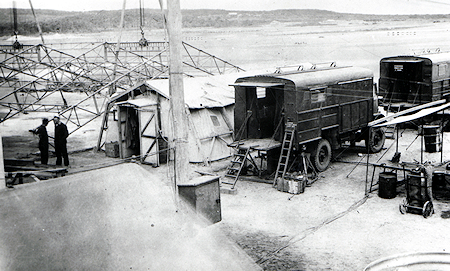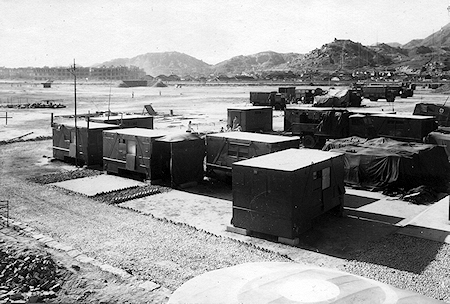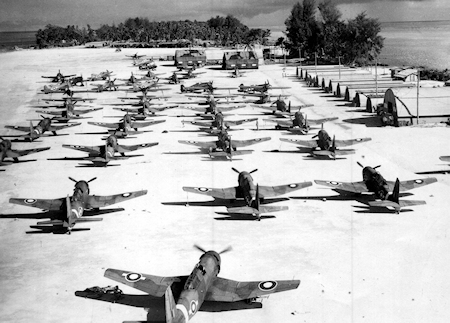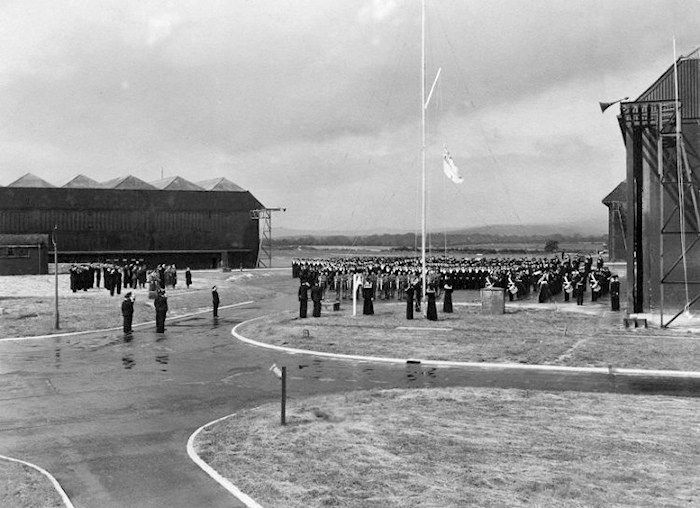Mobile Naval Aviation Support

All the capabilities of an air station or aircraft carrier that can be dispatched to any location on the globe. A basic MONAB consisted of the following components: Non-technical - Command & Executive, Medical, Stores, Flying Control, Radio & Radar. Technical - Maintenance Servicing, Mobile Maintenance, Maintenance Air Gunnery, Maintenance Air Radio. Smallest ship’s company totalled 517 (MONAB VII). Additional ‘bolt-on’ socialist components Maintenance, Storage & Reserve Unit, Mobile Repair, Mobile Air torpedo Maintenance Unit. Depending on which, and how many additional components were added a MONAB complement could exceed 1000 men.
Containerised workshops & Specialised vehicles

Large numbers of specialist vehicles, trailers and other equipment had to be sourced, or specially constructed, to provide the mobile facilities. Containerised workshops and offices, flying control and VHF and D/F vans, IFF transmitter, receiver & display van, landmark beacon trailer, Meteorological van, Photographic tender, medical and dental dispensaries, Bakery, electrical generating, camp lighting, water purification plant, crash tenders, ambulances, and more. canvas covered portable aircraft hangars and wooden framed, canvas covered, buildings were supplied for aircraft maintenance parties.
Could be Installed on any airstrip

The MONABs were designed to either construct their own airstrip by attaching a Royal Marines Construction Battalion to the complement, ort to occupy a captured emery airstrip where the basic airfield facilities were already built. In the pacific it was envisaged that the MONABs would move forward following the fleet on its advance towards Japan, occupying captured airfields when they became available; as the operational area moved further away the MONABs would ‘leap frog. each other.
The concept
In October 1942 the Director Naval Air Division (D.N.A.D.) began searching for a method for providing airfield facilities more quickly and more economically, both in labour and in materials. It was at this time that the idea of a Mobile Naval Airfields Organisation was born. It would be the middle of 1944 before sufficient resources became available to begin assembling the first Mobile Naval Air Base.
There were 17 units planned, 15 Mobile Naval Air Bases (MONAB) and 2 Transportable Aircraft Maintenance Yards (TAMY). 9 MONABS and 1 TAMY operated during the last years of World War Two. Without the contribution made by these units and the men who served in them, the British Pacific Fleet could not have participated in the final stages of the conflict in the Pacific.
Commissioned Units
Ten MONABs and one TAMY commissioned, ten of them were to see active service.
|
Unit |
Ship's name |
Commissioned (UK) |
Paid Off |
|---|---|---|---|
|
NABBINGTON |
28 Oct 1944 |
15 Nov 194 |
|
|
NABBERLEY |
18 Nov 1944 |
31 Mar 19 |
|
|
NABTHORPE |
4 Dec 1944 |
15 Nov 1945 |
|
|
NABARON |
1 Jan 1945 |
10 Nov 1945 |
|
|
NABSWICK |
1 Feb 1945 |
18 Mar 1946 |
|
|
NABSTOCK |
1 Apr 1945 |
9 Jun 1946 |
|
|
NABREEKIE |
1 Jun 1945 |
5 Nov 1945 |
|
|
NABCATCHER |
1 Jul 1945 |
1 Apr 1947 |
|
|
NABROCK |
1 Aug 1945 |
15 Dec 1945 |
|
|
NABHURST |
1 Sep1945 |
12 Oct 1945 |
|
|
NABSFORD |
1 Feb 1945 |
31 Mar 1946 |

MONAB VII commissioning at R.N.A.S. Middle Wallop June 1st 1945
Cancelled Units
Five further MONABs and a planned second TAMY were all cancelled after VJ Day.
|
Unit |
Ship's name |
Commissioned |
Paid Off |
|---|---|---|---|
|
NABSFIELD ?* |
- |
- |
|
|
NABSTEAD ?* |
- |
- |
|
|
NABSMERE ?* |
- |
- |
|
|
Not promulgated |
- |
- |
|
|
Not promulgated |
- |
- |
|
|
Not promulgated |
- |
- |
* NABSFIELD, NABSTEAD & NABSMERE were originally promulgated as the names for MONABs VII, VIII, & IX respectively. For reasons which are not clear these units were renamed as NABREEKIE, NABCATCHER, & NABROCK. Since no other names appear to have been promulgated for the next units to form it is assumed that these names were still intended to be used by MONABs, and in the same order. .